A lot of photographers have the opinion that an investment in new equipment will solve their photographic problems and let them make better photos. In most cases this is an illusion. I am still amazed how little you actually need for a good photo. On the other hand, it is true that there are some cameras that enable a photographer to break new ground. For example, without the Ermanox, using 4.5×6 cm glass plates and its fast Ernostar f/1.8 85mm lens of 1925 the available light photography and famous candids of Dr. Erich Salomon would not have been possible. To a certain degree this is the case with the Rolleiflex 6008 professional for me.
This camera allows me a way of working I could hardly achieve with another camera. First of all, there is the waist-level finder. It enables me to see the overall picture on the ground glass but also to talk to the person I am photographing. With an SLR I always found it annoying to have a camera body in front of my face. Working with a waist-level finder helps to build up trust and a certain level of intimacy between the photographer and the person who is being photographed.
During a portrait session I don’t want to hide myself behind a camera. Taking portraits is, for me, a form of conversation between two people. These conversations don’t have to be pleasant all the time and I have the opinion that you won’t receive anything if you are not prepared to give something. Due to the waist level finder of the Rolleiflex it is possible to position the camera in a way it does not catch someone’s eye.
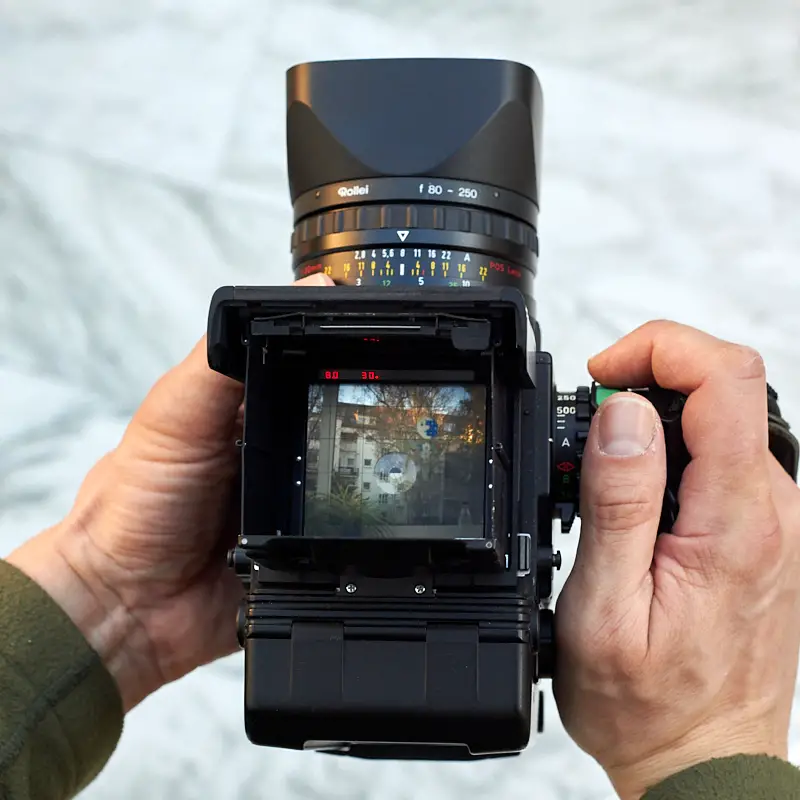
Portrait photography – an individual point of view
The Approach
My intention with portrait photography is to unveil the characteristics of a person in such a way that the person recognizes themselves. Old portrait photographers in Germany called this “charakteristische Ähnlichkeit“ – characteristic resemblance. Thus, I don’t view myself as a director and I don’t reenact photos. My approach to portraits is similar to someone collecting semi-precious stones – I look at them, put them into the light and discover their individual beauty. Others may prefer to cut these stones but I regard this as losing their characteristics. I think that I have to respect every person, their characteristics, individual story and beauty. What I aim for is the moment you get an insight in a person. Oddly I think that you can’t achieve this by total control but rather the opposite – giving space for the unplanned.
The reasons that I don’t make “neutral” photos either, like a photo booth, is that my personal taste and experience functions like a mirror made of little coloured pieces of glass reflecting the picture. In other words, however I try to do a neutral portrait, my personality is always included in the result.
In most cases, I don’t know what awaits me – the person, the environment and the light setting are unknown to me in advance. Therefore, I have learned that in most cases it is helpful to be able to adjust your visual idea. There is no standard approach to a meaningful portrait. If you stick to a certain pattern you will also end up to with these meaningless photos that you will see in most High Street studios. For me, photography has more to do with feeling than actually seeing something. I try to understand how I feel about something or someone. In that situation I totally rely on gut instinct. Sometimes you can simply feel if a picture will be good. Taking photos for me is to take up a position.
Don McCullin once said in an interview, “Photography for me is not looking, it’s feeling. If you can’t feel what you’re looking at, then you’re never going to get others to feel anything when they look at your pictures.” I totally agree with that point of view.
Fred R. Conrad then staff photographer of the New York Times photographed the famous photographer Joel Meyerowitz in 2012. He used a Rolleiflex 6008 with a f/2 110mm Zeiss Planar lens. This short film “Photographing the Photographer” of the NYTimes Lens blog gives an interesting insight in his workflow and approach.
The Technique
Daylight is something that is not easy to handle as a photographer but it can be rewarding to try. With skilful positioning of a person and some basic tools you will be able to work with daylight very well. One of these basic tools can be a flat Styrofoam sheet on a lighting stand used as a reflector. I have used this combination for assignments. Also, a reflector you can buy from several manufactures is helpful for brightening up or reducing the light.
For most of my black and white pictures I use the classic Kodak Tri-X 400 film but also Fuji Neopan Acros 100. The portrait of the artist standing in the mountain of waste-paper was taken with Acros film. For colour I choose Kodak Portra 160 & 400 negative film. Last year I also tried a roll of Ektachrome E100 and liked the rendering and cooler colours. I think that the Rolleiflex 6008 with a prism finder and Ilford Delta 3200 set at 1000 ASA is an interesting combination for me as the 6×6 format provides more quality reserves compared to 35mm and the higher speed enables hand held photography in more settings.
Together with a stable tripod/head combination and the mirror-lock up, a slow shutter speed is a good option. As I learned, the MRC 120 electronic remote release is a very useful accessory as it makes it very convenient to use the mirror lockup. The matte box used on the front of the lens is also an item I can highly recommend.
In most cases I use an old Pentax Spotmeter V as it gives me more freedom, therefore ignoring the sophisticated exposure metering of the Rolleiflex 6008, which is a shame. Mostly, I mount the camera on a basic Manfrotto 055XB aluminium tripod, with short centre column and rubber spiked feet, a Novoflex Classic Ball 3-way head and Manfrotto 030 adapter plates. I also would consider heads from FOBA, Arca-Swiss or Linhof.
Don’t get dominated by the technical aspects as if they are your “only” your tools. Learn how to use them blindfolded – and then forget about them.
Here is where the Rolleiflex 6008 comes in. For me it is the perfect tool for doing portraits as it perfectly supports my flow of work, letting me concentrate on engaging with my subject.
The concept of the Rolleiflex 6008
Using the Rolleiflex 6008 made me appreciate the underlying concept of the camera. There is no complicated setting; most of the camera is self-explanatory. You realise that the Rolleiflex SLX of 1976, from which the Rolleiflex 6008 descends, was a well thought out camera concept. Everything gives the impression of all of being one unit. No additional motor drive or prism finder needs to be added to use features like shutter priority. The electronics built into the camera is not an end in itself but is support for the photographer – if desired. I found the motor drive with two frames per second very helpful and the noise never annoyed me. Automatic wind up to the first frame and wind off at the end of each roll are very convenient on a busy photo shoot.
I also own an early Hasselblad 500C/M with an f/2.8 80mm Zeiss Planar standard lens. It is a beautiful camera in its own right but I never would exchange my Rolleiflex setup for a Hasselblad. I find the Rolleiflex system better to work with. That said I bought the Hasselblad because together with an 80mm lens and a waist level finder it is a very compact and capable set you can walk around town with all day.
Rolleiflex 6000 Advantages
There are some features in this camera I would miss a lot, like the brilliantly designed laminar dark slide, which is much better than the metal dark slides normally used in other cameras and also the film inserts that makes loading new film as fast as with a Nikon and the different exposure modes you can use without any additional prism viewfinder. In fact, the Rolleiflex 6008 is the only 6×6 SLR camera that combines metering with waist-level viewing. The Rolleiflex 6000 system is also the only 6×6 system to display aperture and shutter speed in the waist level viewfinder. The LEDs also signal the use of exposure compensation in 1/3 stops, meter lock and spot metering.
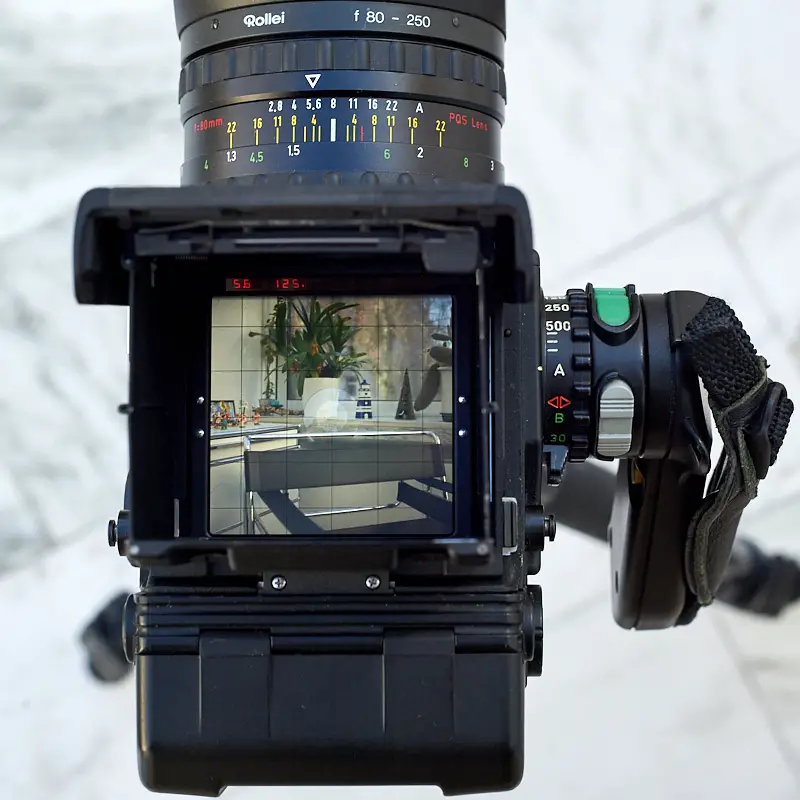
One advantage most photographers won’t even realise but which is quite important, is that the film plane is set on the body rather than in the magazine. The film is pressed up against some rails in the body so that the film plane is independent of the back installed. In, for example, Hasselblad cameras, the film plane is in each magazine back, which requires the back to be adjusted precisely to the body to sustain maximum sharpness.
Together with PQS lenses, the Rolleiflex 6008 professional can use 1/1000th second (watch the three lines on the shutter speed dial) even with flash units. This fast flash synchronisation is even at today’s standards today, state of the art.
The development of the Rolleiflex 6000 series was quite evolutionary. Comparing the Rolleiflex 6008 professional to the younger 6008 integral2 and 6008 AF I can’t see any advantage of these cameras to the professional which would be essential to me. If you want to use 4,5×6 film (16 pictures per roll 120 instead of 12) with the 6008, the 4560 rotating magazine will be an interesting option because it is possible to switch between horizontal and vertical format simply by turning the back. This magazine can’t be used with the 6008 professional as this magazine was designed later but for use with the 6008 integral/E and newer cameras.
Metering
Only few medium format cameras are combining TTL-light metering, allowing shutter and aperture priority and a waist-level viewer, like the cameras of the Rolleiflex 6000 system. Metering with the 6008 is straightforward. A large knob on the left side of the camera selects three modes: Centre-weighted multi-zone metering, Spot-metering (approximately 1% of frame area with an 80mm lens) and Multi-spot metering by metering and storing up to five spot readings.
One area where Rollei is head and shoulders above the 35mm crowd, is the manner in which automatic exposure is selected. Rather than a complex display and a multi-function dial, Rollei added an “A“ setting to the aperture ring and the shutter-speed dial. Move the aperture ring to “A“ and you get shutter-priority. Move the aperture back to an aperture number and the shutter-speed dial to “A” and you get aperture priority. Move both to “A“ and the camera will now automatically select a suitable shutter-speed/aperture combination. Select for example 1/125th and f8 and you get metered manual.
Auto bracketing (up and down 2/3 stops) is a feature of the camera I have never used due to my current workflow as I often work with a tripod and a handheld exposure meter and do it manually. Whereas locking the exposure value, by pressing a button next to the shutter speed dial, turned out to be helpful in some occasions. I expect that the internal metering system of my Rolleiflex 6008 will be of growing interest to me when working handheld more often.
Viewfinders
The standard viewfinder of the Rolleiflex 6008 is the waist level finder. It is ideal for composing carefully and for portraits. Starting with 35mm SLRs, I easily understood the advantages of the waist level finder and I find composing a picture with the waist-level finder extremely effective. The three-dimensional impression of the focusing screen is an amazing concept for me. Additional 45 or 90-degree prism finders, a magnifying hood or two other very special finders can be used to. I bought a 90-degree prism finder with the intention of using the 6008 more often handheld like a classic SLR. It can be rotated to four different positions spaced 90° apart so that it makes for comfortable viewing even in awkward shooting positions. As the viewfinder is mounted, its display is automatically adjusted for laterally correct presentation. Additionally, there is an a cleverly designed loupe magnifier which can also can also be used as a loupe for checking 6×6 negatives and slides.
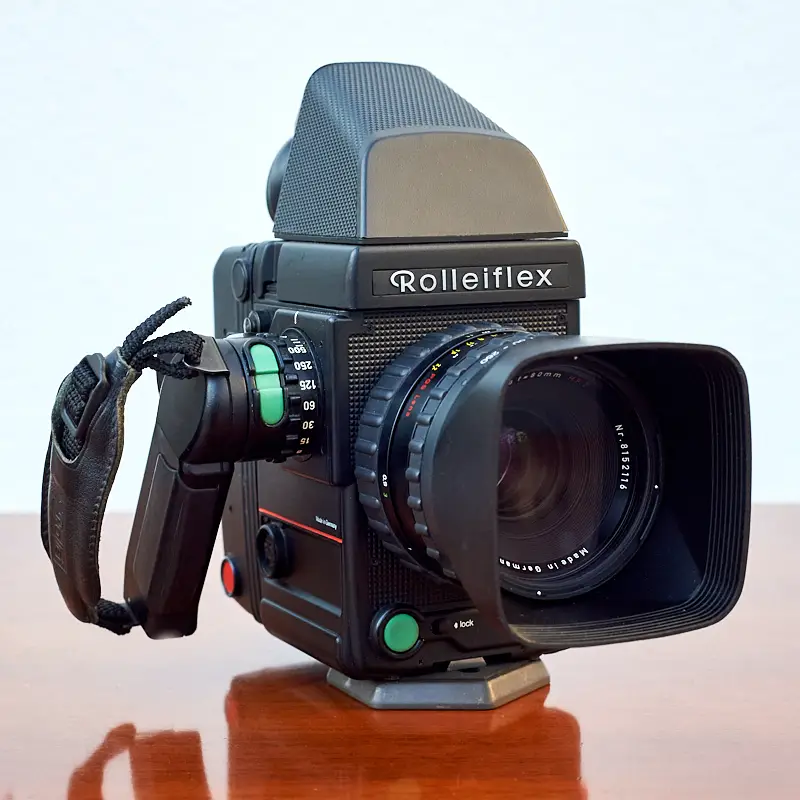
The standard High-D focusing screen is already a bright one and includes a central split image, micro prism collar and a grid of fine lines for framing. Compared to my old Nikons, I found focusing with the Rollei screens sometimes difficult because, with the much narrower depth of field when compared to 35mm, focus has to be set precisely. This is the case especially in dark environments like factories. After some years I changed the standard screen for a Maxwell Precision Optics Hi-Lux screen, which is significantly brighter at the edges. A less costly alternative is Rick Oleson Bright Screen.
No matter which finder and screen is used, the LED displays are visible and read the correct way round. The microcomputer electronically mirrors all displays to compensate for the installation of a prism finder.
Action grip
The Rolleiflex 6008 has an “action grip” that facilitates one-handed operation by right-handed photographers. This small handle plugs quickly in or out of the shutter speed dial when the shutter speed dial is set to a special position. The grip has a camcorder-like strap, cushioned with leather, which goes around your fingers. Rotation into any one of four positions is possible. A shutter release and the meter lock button fall easily to hand, as does the switch for camera power and motor drive mode. It is the game changer of the whole system. The grip changes the way you use this camera and easily enables handheld shooting. Together with a prism finder and the exposure automation, the 6008 can be used like a large SLR camera for photojournalism and portraiture.
Film inserts
The ingenious film inserts can be preloaded and make changing film as fast like as with a standard 35mm SLR camera. Doing portraits and using some preloaded film inserts enables me to easily to continue photographing and whilst avoiding interrupting the positive tension in a portrait session. Also, the film inserts effectively makes a second magazine unnecessary, which saves weight and money. Owning a second magazine is only useful if you tend to change between different film types frequently. Therefore, owning some film inserts is a very good investment in my eyes and highly recommended.
The design of the film insert is another example of how well thought out the Rolleiflex 6000 system is in every detail, as they are symmetrical. This makes loading quite convenient – you just remove the film insert from the magazine, remove the exposed roll, turn the insert 180°, put in a new roll of film and put it back into the camera. So, you don’t have to change the empty spool to the other side of the insert like with a Hasselblad.
When buying used film inserts it is important to differentiate between types for the SLX and the 6000 system. SLX type inserts are slightly different in size resulting in jamming into the 6000 magazine, making them difficult to remove. The old SLX film inserts are marked with a large white triangle on the inside of the insert. The Rolleiflex 6000 type inserts have a much smaller white triangle on the outside. This short film describes how easily the film loading is done.
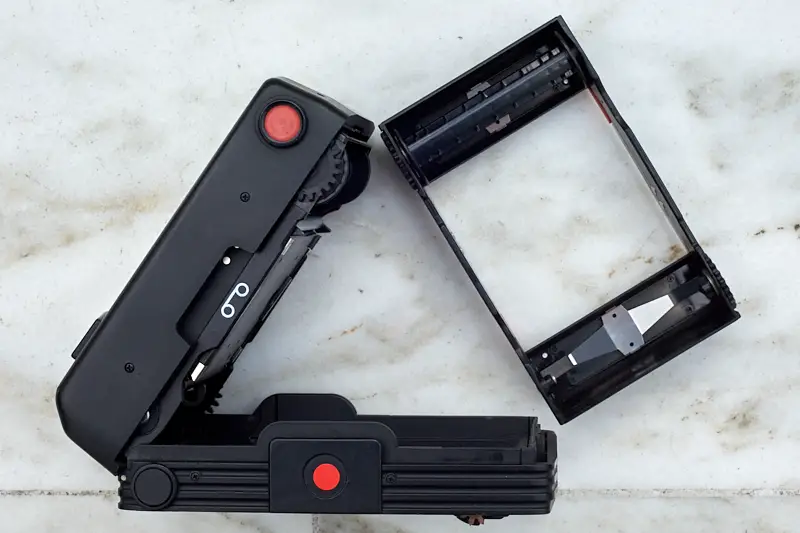
Image Quality & Lenses
Not surprisingly, the image quality of a medium format camera is great and makes someone (like me) wonder why he worked for so long with 35mm cameras. The Zeiss and Schneider-Kreuznach lenses are excellent. The range of lenses is extensive and include lenses like the 55mm Schneider Super-Angulon PCS wide angle shift lens or exceptionally fast lenses like the f/2 80mm Schneider Xenotar and a f/2 110mm Zeiss Planar. The lenses I used in the beginning are the f/2.8 80mm Zeiss Planar and the f/4 150mm Zeiss Sonnar. The 80mm focal length is a lens which is surprisingly versatile and which should not be underrated. For my artists’ portraits I relied just on these two lenses. In the following years I bought a f/4 40mm Zeiss Distagon FLE, a f/2.8 50mm Schneider Super-Angulon, the f/2 110 Zeiss Planar and finally a f/5.6 250mm Zeiss Sonnar. All lenses of the SLX/6000 system have 1/3 stop settings.
Rollei always offered a budget line of lenses called “Rolleigon” (made by Tokina) or later “EL” for “economy line” (made by Zeiss). Both with a 67mm screw-in filters thread instead of the Rollei VI bayonet mount. The “EL” line of lenses basically had no external window for the aperture setting. The Rolleigon lens range was intended for use with the SLX, 6002 and 6006 cameras. Together with the, then newly released, PQ lenses the Rolleiflex 6008 allowed open aperture metering for the first time. Therefore, mounting a Rolleigon lens on a 6008 means that you can’t use capabilities like the automatic exposure modes, the multi-spot metering, the display of the aperture in the viewfinder and auto bracketing. You can use Rolleigon lenses on a 6008 in the manual mode, checking the exposure with the stop-down button each time. Due to this, using newer “EL” and “PQ/PQS” lenses on a 6008 would be the better choice in my opinion.
To give an impression of the capability of the whole optical system – for exhibitions I scanned the 6×6 negatives with a Hasselblad Flextight scanner and printed on Alu-Dibond and there was are no problem achieving 120 x 120 cm prints.
The convenience of a bayonet mount is very compelling to everyone who has ever cut his hand with a jammed screw-in filter. The downside is that these filters are ridiculously expensive. Heliopan filters from Germany are more reasonably priced and optically the same. Adapters from 67mm & 72mm thread to Rollei VI bayonet mount and from Bay VI to 67mm do exist. So, I can also use my Rollei VI filters on my Fujica GW 690 camera with a 67mm screw thread. Alternatively, the Formatt-Hitech and Lee resin 100mm filter systems are a good option, too.
Rolleiflex 6000 Disadvantages
Since photographing with the Rolleiflex 6008 professional, I have not come across serious disadvantages. The most “serious” was the problem with focusing when using the waist level viewer and the standard viewing screen. This is something I got accustomed to with more routine.
An often mentioned “disadvantage” of the whole Rolleiflex 6000 system compared to other medium format cameras is that without energy the camera is “dead”. Honestly you will have to admit that with the capabilities of the Rolleiflex 6000 series much would not be possible with an all-mechanical system. After some years, I use Ni-MH cells with 1300 mAh from Paepke Fototechnik in Duesseldorf (Germany). This requires either a new and much smaller charger from Paepke or the modification of the Rollei charger. Since that time, discharging cells is not an issue any more. The use of Lithium polymer cells was never approved by Rollei. DIY solutions can damage the motherboard of the camera as comprehensive knowledge on the internal voltage is required. Putting the camera back into the bag still switched on is not something the camera appreciates. As there is no automatic switch off, the battery will be discharged by the following day. As a careful photographer you might invest in a backup battery but I never got into a situation where I lost photos due to an empty battery.
Compared with the available supply of used Mamiya or Hasselblad magazines, lenses and accessories, the second-hand market for the Rolleiflex 6000 system is small and it seems a lot has been sold to the US and Asia in the past. Good sources are Eric Hiss of Rolleiflex USA and Ffordes in Scotland.
When I bought a second used Rolleiflex 6000 magazine, I soon realised soon that it had a problem with overlapping frames, which was quite annoying. It meant that I lost three pictures from a 12-picture roll. A fair, complete exchange of the magazine by mechanics at DHW Fototechnik (now DW Photo) in Braunschweig solved the problem. The automatic film advance of the SLX/6000 system, requires an electronic encoder instead of a simple mechanical spacing regulator for film winding; this became the potential source of the problem. It can also be the reason why frames are not always evenly spaced, which can be just a bit irritating when noticed but is not really a problem at all.
My Lens Setup in Detail
The list of lenses for the Rolleiflex 6000 system is comprehensive. It ranges from the f/3.5 30mm Distagon fisheye to the f8 1000mm Tele-Tessar. All Zeiss lenses of the Rolleiflex 6000 line up are the same as for the Hasselblad 500 series. The only difference is the shutter – Rollei electronic, Hasselblad mechanical. There are also some interesting Schneider-Kreuznach lenses available for the Rolleiflex, too. Lenses like the f/2.8 50mm Super-Angulon, the f/2 80mm Xenotar or the f/4 300mm Apo-Tele-Xenar are excellent quality options to the well-known Zeiss equivalents. Schneider also offered two zoom lenses for the Rolleiflex 6000 system. The f/4.5 75 – 150mm Varigon, one of the few zoom lenses in medium format, is also an interesting option.
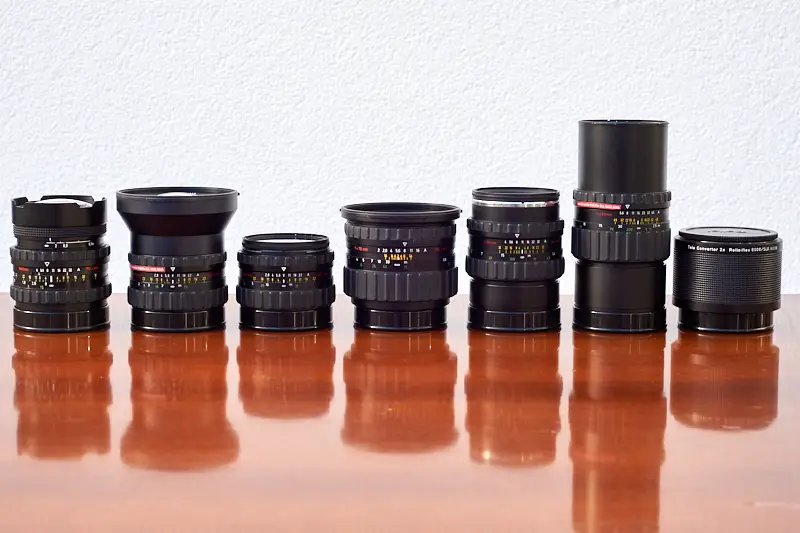

f/4 40mm Zeiss Distagon FLE PQ
The 40mm lens compares to a 26mm lens in 35mm terms. It is the widest non-fisheye lens of the lens range. In contrast to the famed 38mm Zeiss Biogon on the Hasselblad SWC it is more versatile as it does not require a special body and can be used with a prism and waist level viewfinder instead of just a simple viewfinder. The Distagon has no distortion and provides exceptional image quality. A manually adjustable Floating Lens Element (FLE) ring on the front can be used to improve close-distance image quality. As the lens itself has no filter thread the specially designed lens shade is essential when a filter will be used. If you find the FLE ring annoying, the f/3.5 40mm Schneider Super-Angulon is an option because the floating elements are moved by the focusing ring and not by a separate one.
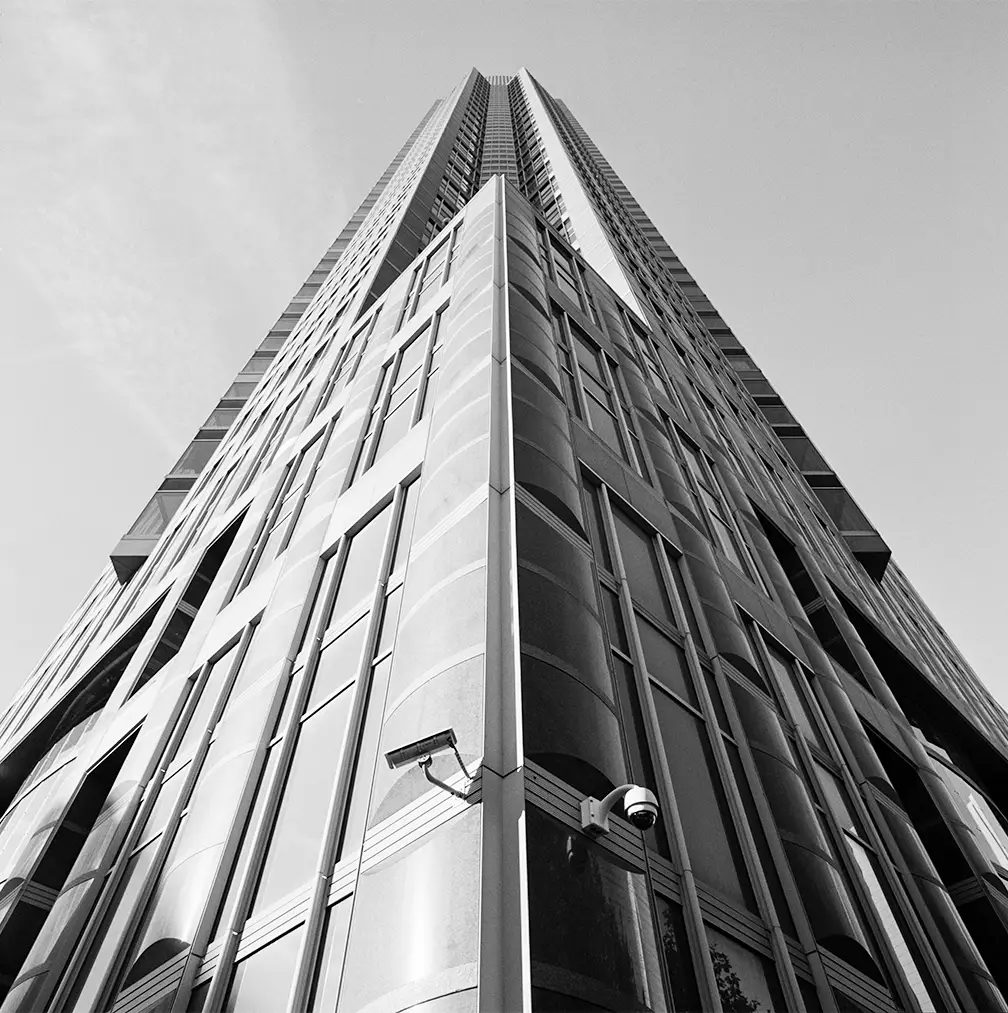
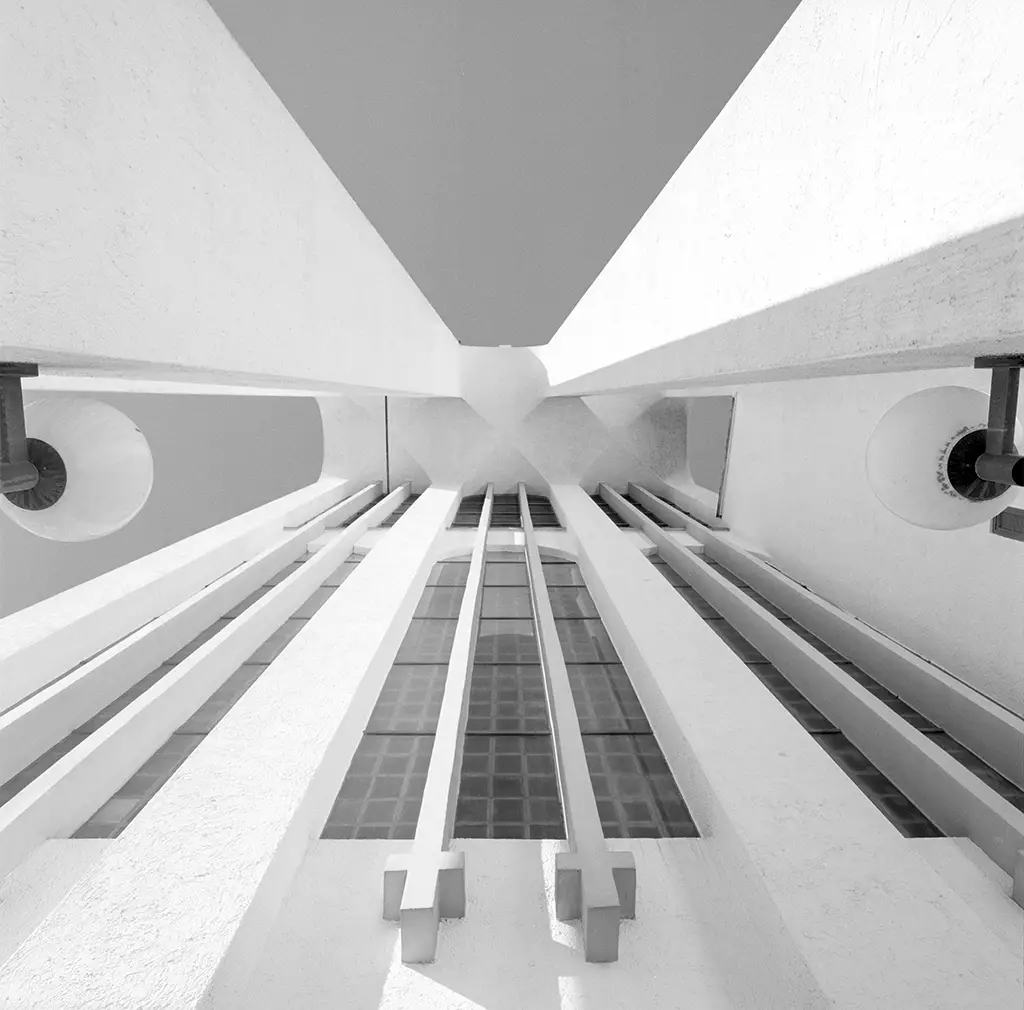
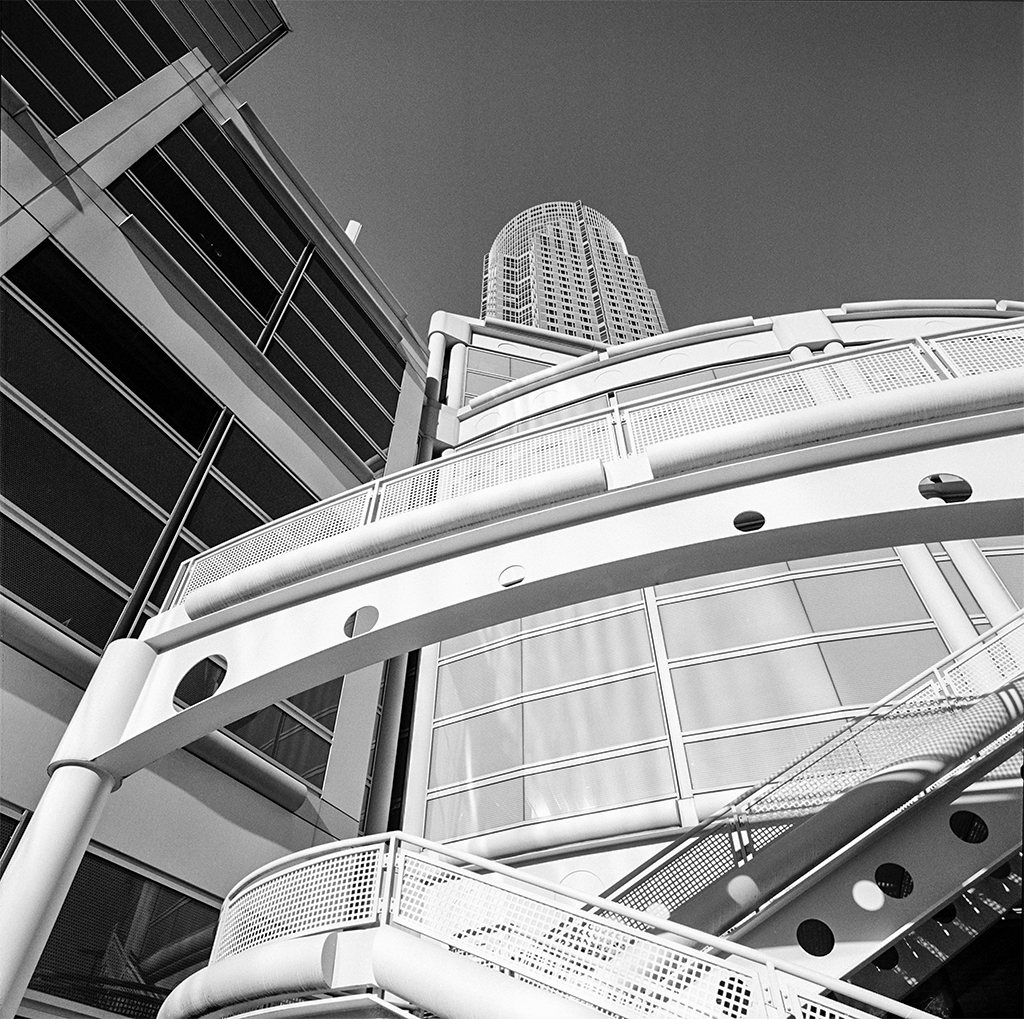
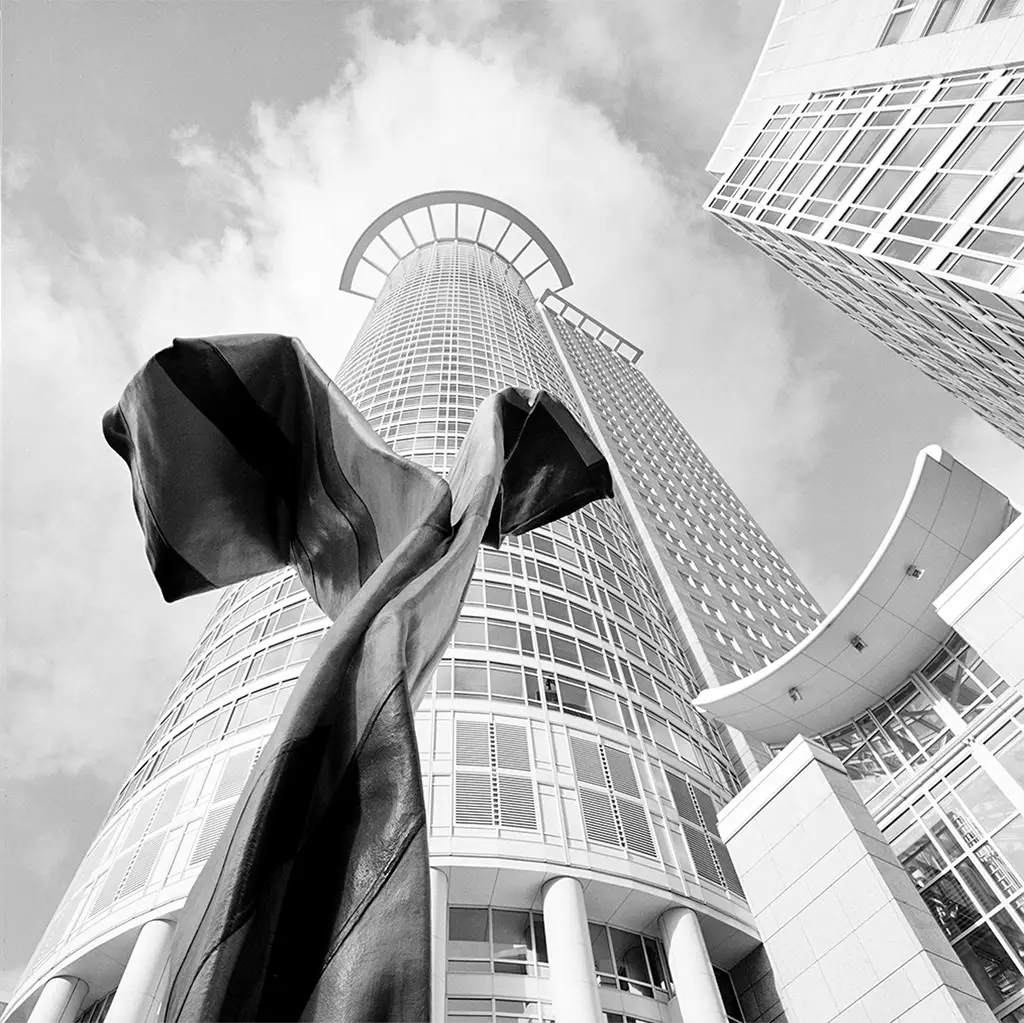
f/2.8 50mm Schneider Super-Angulon PQS
A fast wide-angle lens. This is a 32mm lens in 35mm terms. Because the Super-Angulon is a significantly faster lens than the standard f/4 Zeiss Distagon, a large front element is required. This results in a large 95mm filter thread.
f/2.8 80mm Zeiss Planar PQS
The versatile standard lens. The f/2.8 80mm Schneider Xenotar can be an attractive alternative if you favour a different rendering and bokeh.


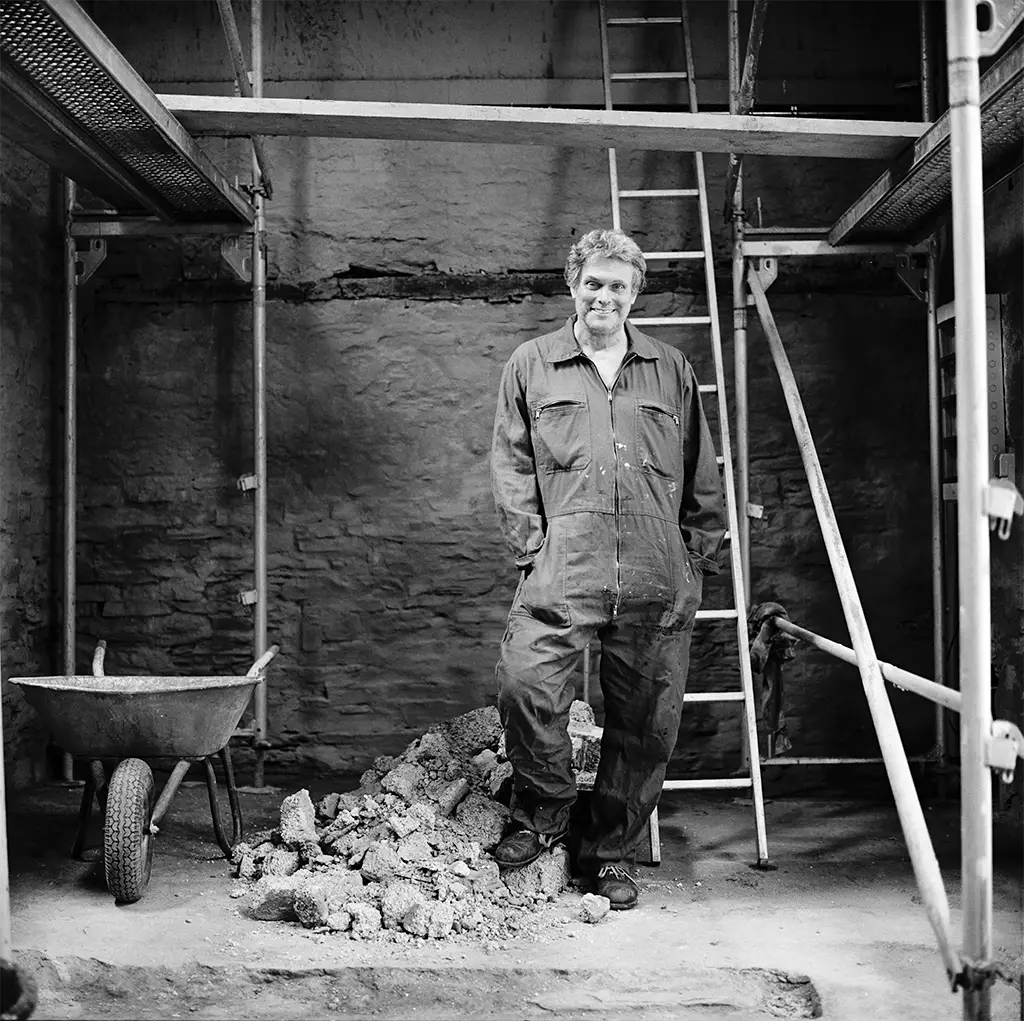
f/2 110mm Zeiss Planar PQ
In my opinion this lens is the holy grail of medium format lens design. The fastest lens in medium format photography. It is a f/1.25 71mm lens in 35mm terms. The Planar has a beautifully bokeh and is razor sharp, too. In the Hasselblad 6×6 system a focal plane shutter body of the 200 series is required to use that lens. Not surprisingly a 95mm filter is required.
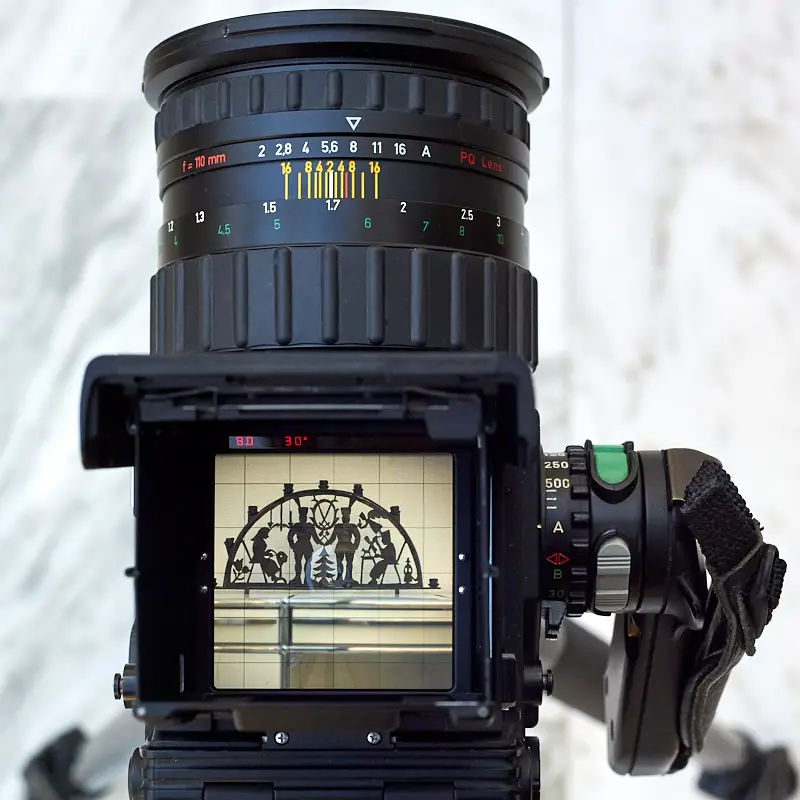
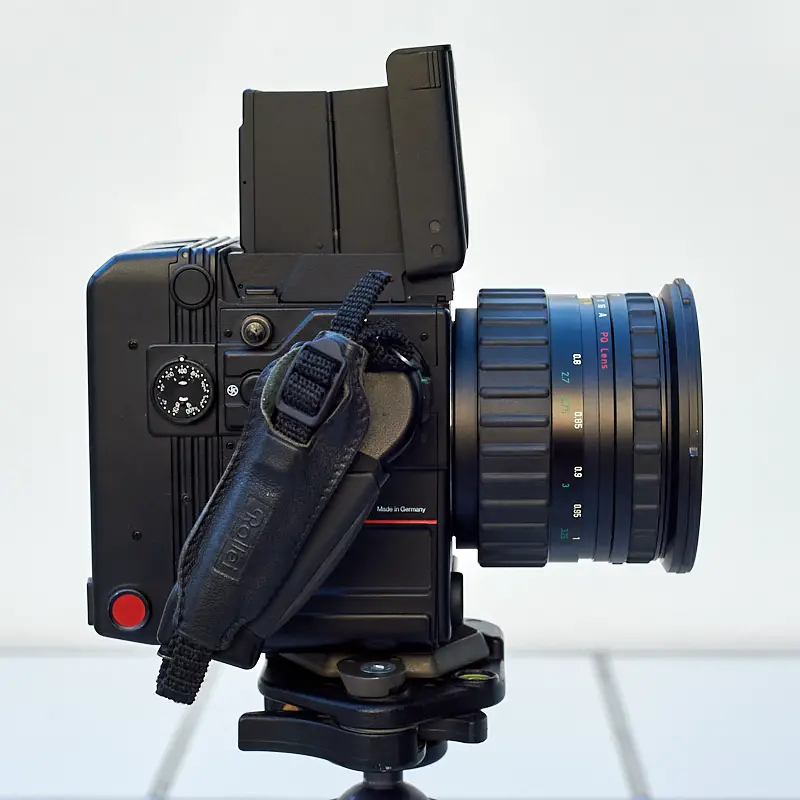
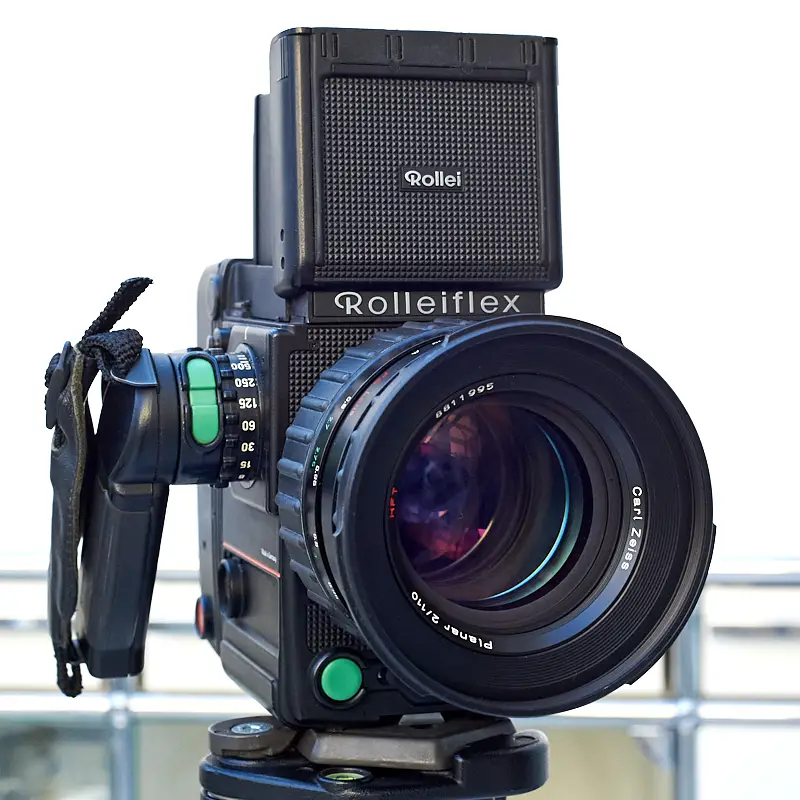
To demonstrate the rendering of the lens I took a serie of porträts of my son Clemens with different apertures starting at f/2. I used Kodak Portra 400 film.





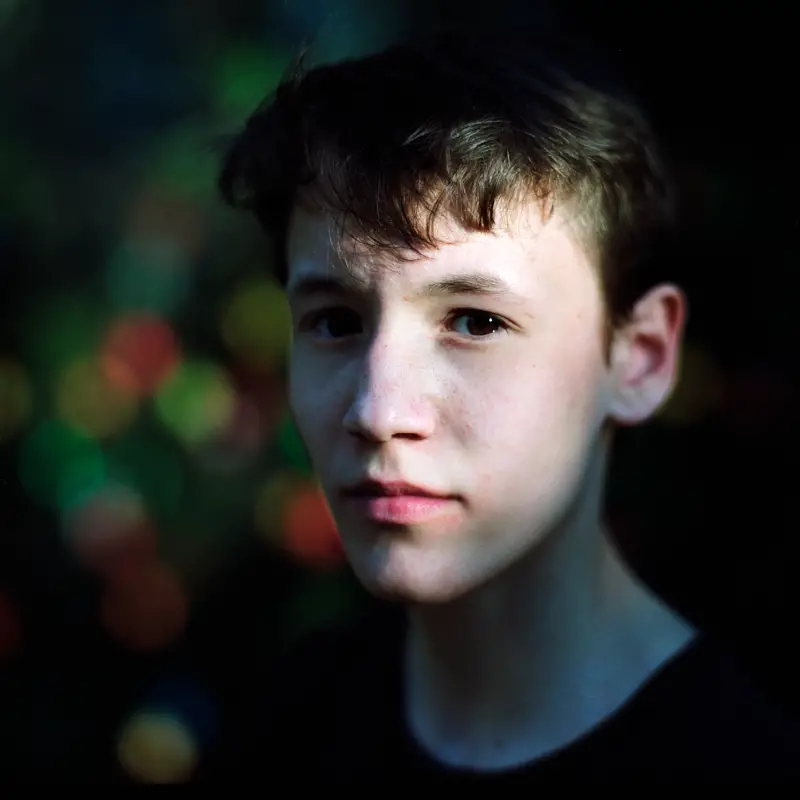
f/4 150mm Zeiss Sonnar PQS
My main portrait lens. It is a 96mm lens in 35mm terms. This focal length provides a distance to my portrait subject, which I prefer. As it is a good compromise between distance and intimacy. The faster f/2.8 Schneider 180mm Tele-Xenar can be an alternative but it weighs 1.5 kg and requires expensive 95mm filters. So, this is a question of personal preferences.
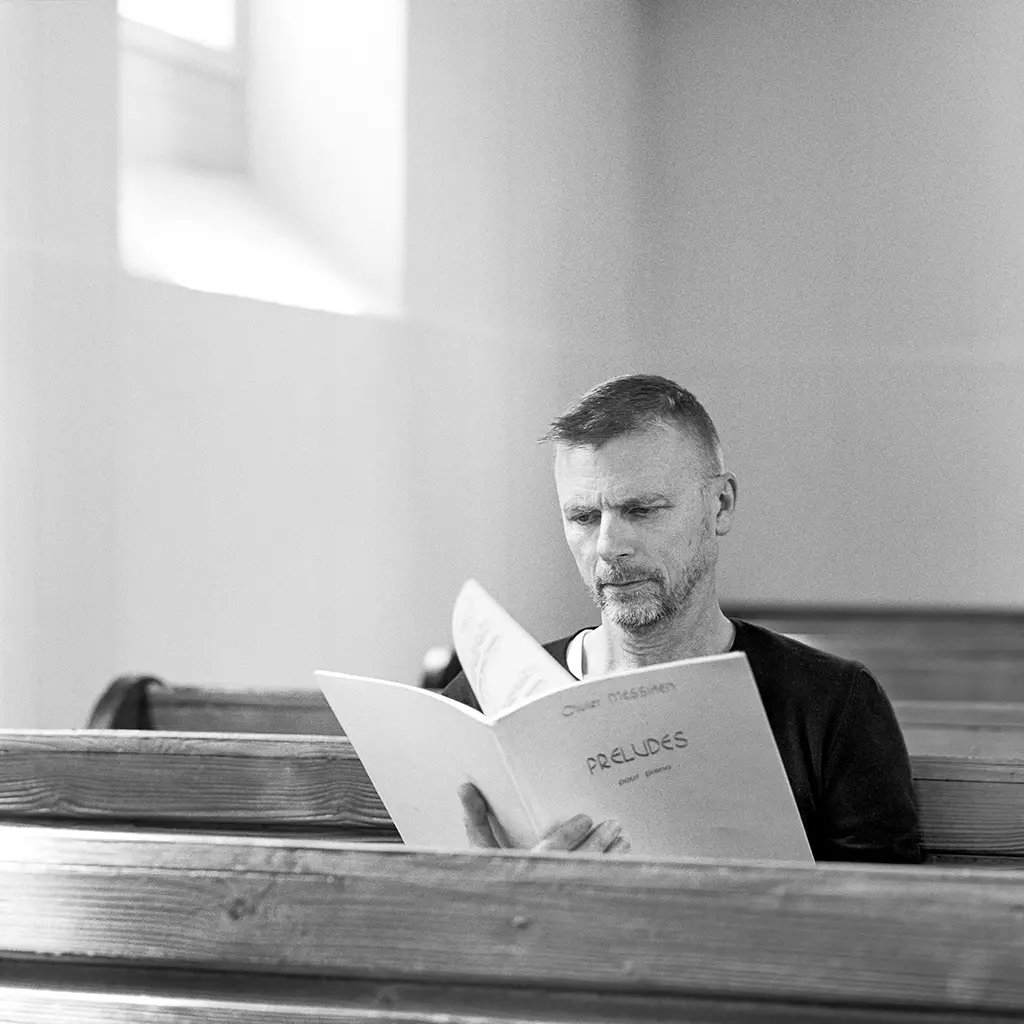
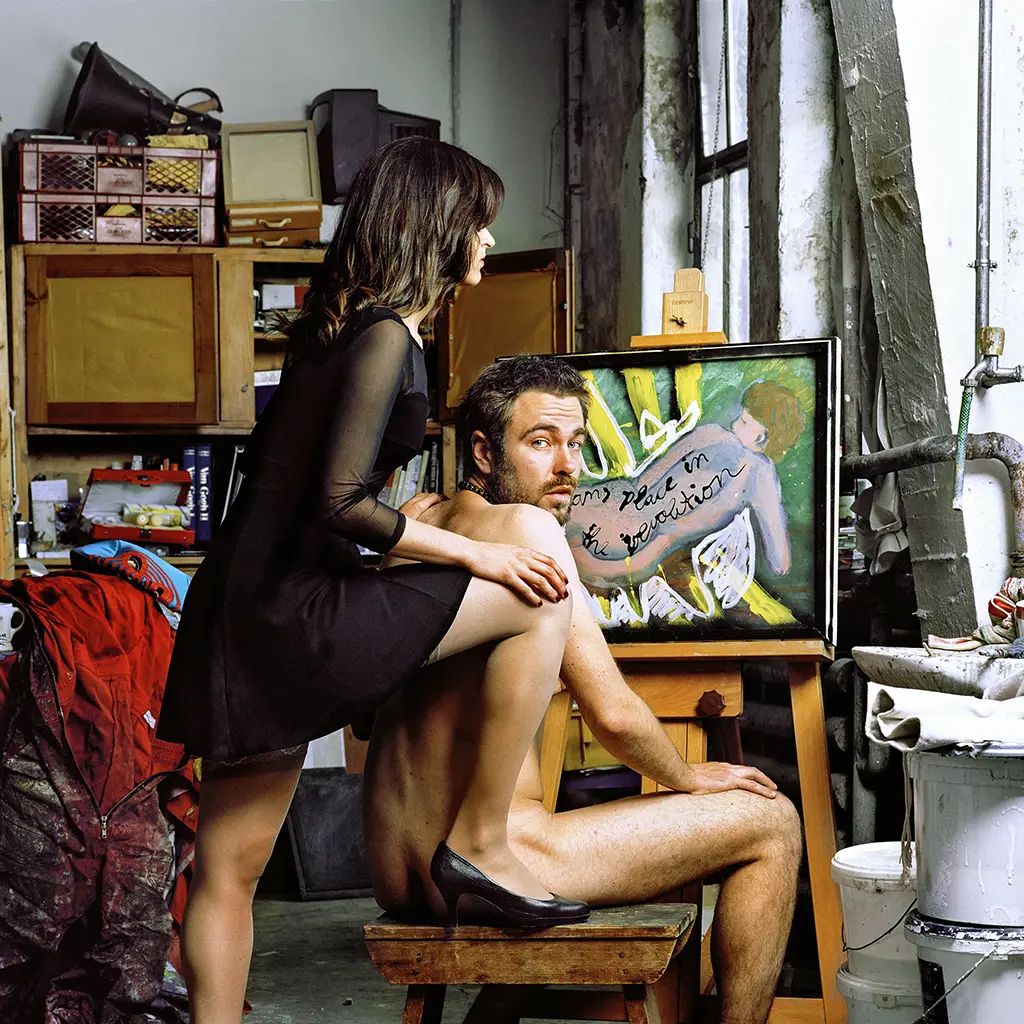

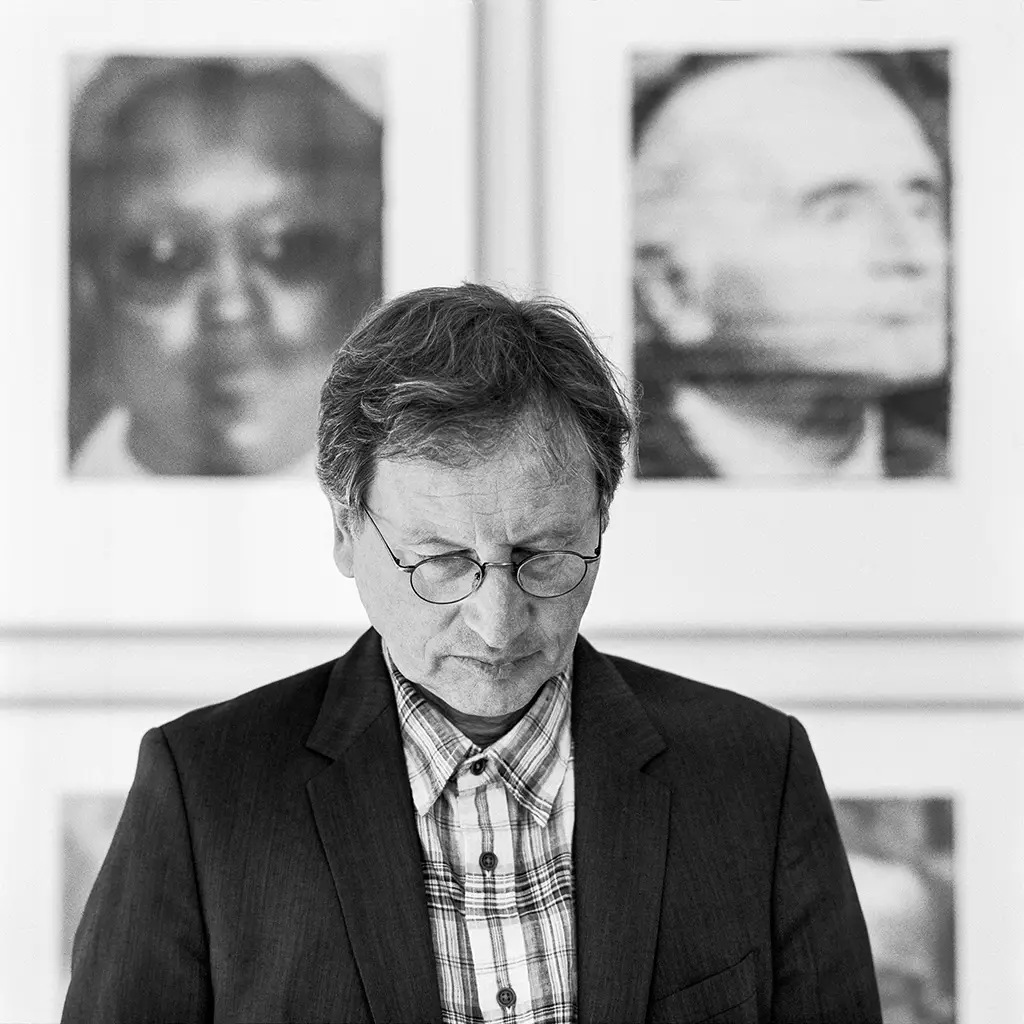
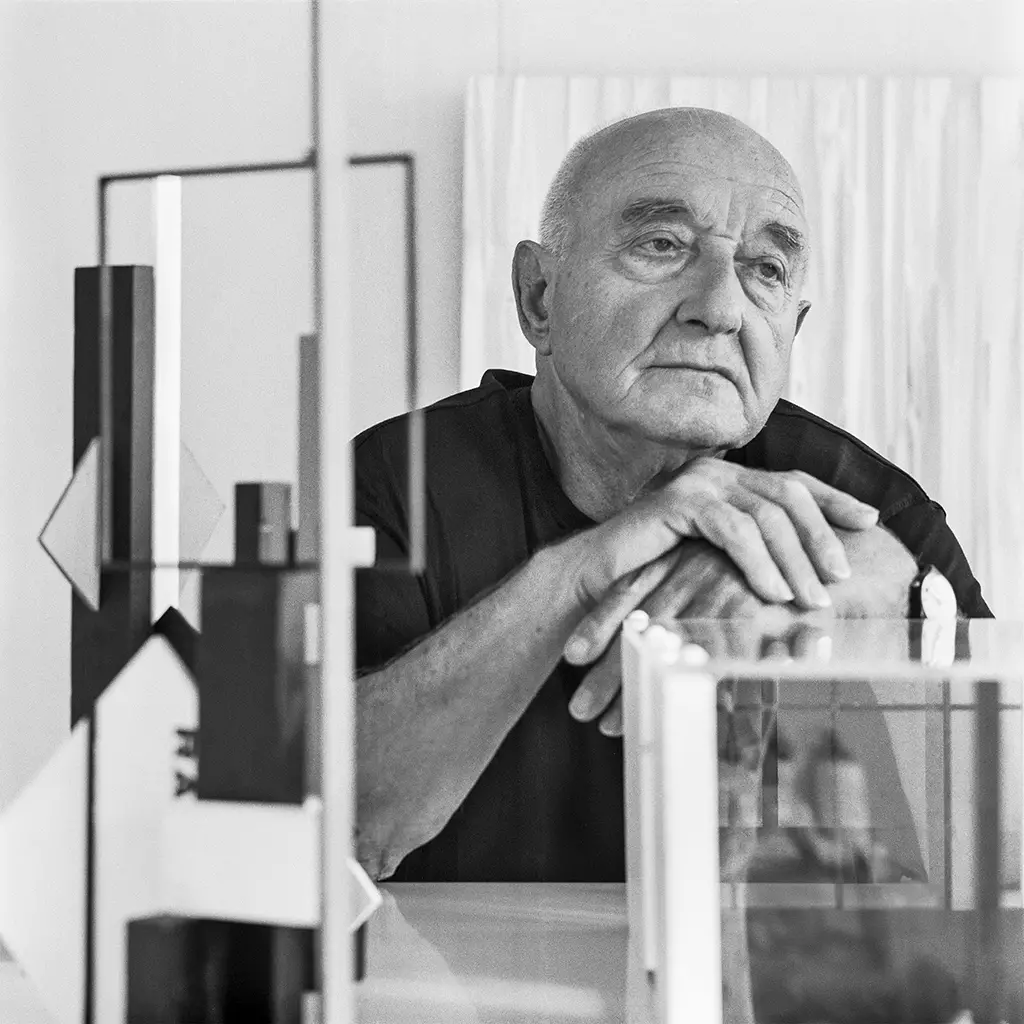
f/4 150mm Schneider Tele-Xenar 150 mm PQS
A few months ago, I have learned that there is also a Schneider offer for the 150mm focal length. As I wanted to compare it with the Zeiss Sonnar I bought a fine copy from Eric Hiss of Rolleiflex USA recently. I have not used it yet but Eric wrote vividly about it: “The 150mm Tele-Xenar is truly one of the jewels of the lens lineup for the Rolleiflex cameras. The odd thing is that the Schneider is every bit as sharp as the Zeiss, sharper even when you measure with Imatest. This is the pronunciation that I speak of – the Zeiss places the emphasis or accent on the fine detail and sort of says it louder. The Schneider is neutral – say each frequency the same. It also has a beautiful bokeh and is less prone to flare than the Zeiss as well.” I am eager to test it myself soon.
f/5.6 250mm Zeiss Sonnar PQS
A 161mm lens in 35mm terms which makes it useful for portraits and landscapes as well. Its relatively compact size makes it easy to handle. Another benefit is that the standard Bay VI filter can be used. As I have bought it recently I have not used it yet.
Tele Extender 2 x
The 2 x extender is very useful as it doubles the focal length of a lens without affecting the minimum focus distance. Initial apertures are reduced by two f/stops. So, the f/5.6 250mm Zeiss Sonnar becomes a f/11 500mm lens. Due to the electronic communication between lens and body the no manual adjustment to the metering system is required.
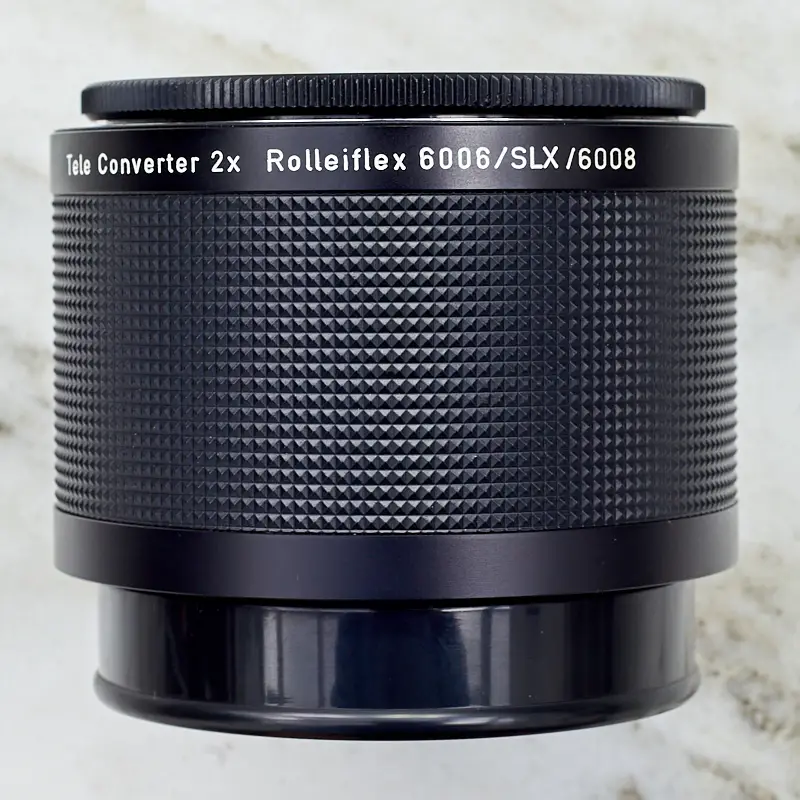
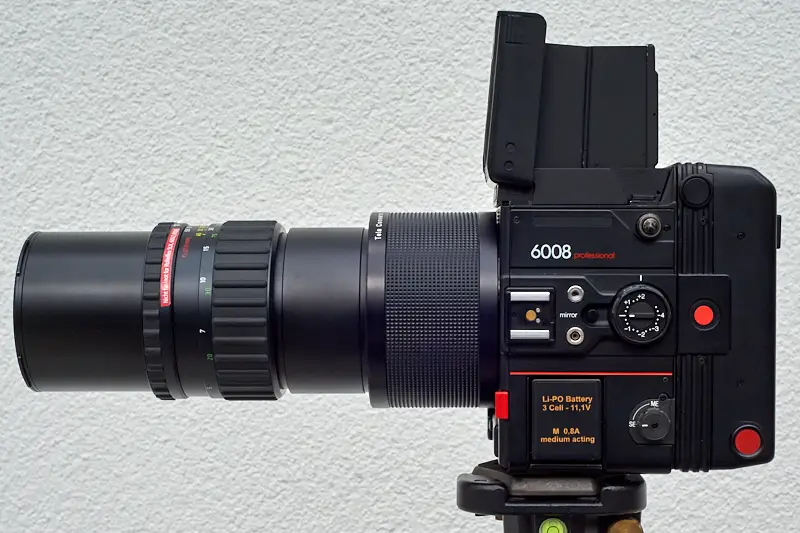
The Schneider-Kreuznach lens options
As mentioned before there are also some very interesting Schneider-Kreuznach lenses available for the Rolleiflex 6000. In some cases, they are identical in aperture and focal length to their Zeiss siblings. But frequently they have no Zeiss counterpart like the f/4 300mm Apo-Tele-Xenar lens. The f/3.5 60mm Curtagon, the f/4 90mm APO-Symmar Macro lens and the f/2.8 180mm Tele-Xenar, are all missing from my review as I don’t own them and had to chance to try them. These Schneider lenses are regarded as some of the jewels of the 6000 system. They have no counterpart in the Hasselblad system at all. This is also another point which sets the Rolleiflex 6000 system apart from the Hasselblad 6×6 system. People who use them point out that Schneider are more neutral than the Zeiss equivalents. They have less distortion, less flare, and a higher sharpness. Most of the older Zeiss lenses need to be stopped down at least two stops before reaching their peak, but the Schneider lenses are really sharp wide open and only get a bit sharper as they are stopped down. Also, all Schneider lenses are all colour matched and have a similar bokeh. So, if you have a photo project and change focal lengths, they will all look the same – and for the crew no changes to the light gels will be required like with some other systems. There is no bad Schneider lens for this system. Even the older f/4.5 75-150mm Variogon PQ and the f/5.6 140-280mm Variogon zoom lenses are incredible. The f/4.6 60-140mm AF/AFD Variogon PQS zoom has the reputation as one of the sharpest lenses currently available particularly in the middle at about 100mm but with 2.4 kg quite heavy. However, for some reason the Schneider-Kreuznach lenses are overshadowed by the Zeiss range. This is totally unjustified. I rather regard these lenses as a hidden gem of the whole system.
Other accessories
Also, a number of accessories for special applications were developed such as the M39/M40 Shutter Adapter or the smart Vario Extension Tube 22-68mm. The M39/M40 enables the use of a number of different lenses without shutters. Originally made for the Schneider M-Componon Macro lenses (28mm, 50mm, and 80mm) this adapter also was employed to fit the classic Rodenstock Imagon lens as well.
Lenses, magazines and viewfinders can also be used on the Rollei X-Act 1 & 2 6×6 monorail view cameras. The lenses with largest image circle in the Rollei lens lineup are the f/4.6 150mm Schneider Apo-Symmar Makro bellows lens, the f/4 90mm Schneider Apo-Symmar Makro, and the f/4 120mm Zeiss Makro-Planar – more or less in that order. All of those lenses will support significant movements on technical cameras.
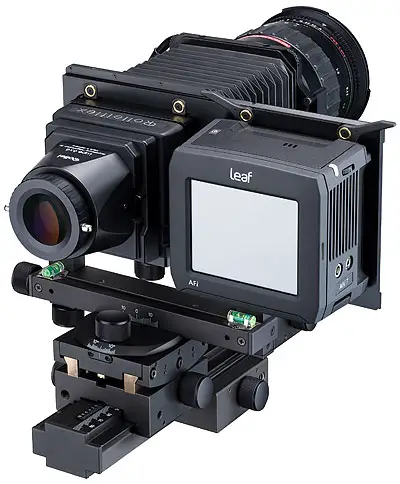
Alpa, the swiss designer and manufacturer of high-end medium format cameras, offered a lens module that allows one to use Rolleiflex 6000 series lenses on their cameras. That should tell you something about the Rollei lens quality. The adapter works very similarly to the Rollei Lens adapter ring for the X-Act 2.
Buying it used
Having in mind that my Rolleiflex 6008 professional was probably built around 1988/89, I sent it for service before using it for the first time. Besides the classic CLA adjustments the camera required new battery cells, adjusting of the exposure metering system, a new focusing screen and lubricating of the gearing mechanism of the motor drive. But this is nothing I was surprised about; no one would seriously buy a 20-year-old Porsche and go straight for a track day on the Nürburgring. For service and repair Paepke Fototechnik in Düsseldorf can be recommended.
Further Rolleiflex 6000 Information
A valuable overview on the development of the SLX and the Rolleiflex 6000 series, their lenses and accessories can be found in Claus Prochnow’s Rollei Report 5 (only in German). There are also two books on the Rolleiflex 6000 system you can buy used: Helfried Weyer’s “Rollei fototechnic” (English/German), Wilfried Mordmüller’s “Rolleiflex 6008 professional und das System 6000” (German) and „Rollei – Das große Handbuch“ by Thomas Maschke and Dieter Beckhusen (German). All books were published in the 1990’s.
I transport my basic Rollei equipment in a custom-made aluminium suitcase with IATA board approved case measurements because I like to see the whole of my equipment laid out in front of me when working. That includes the body, the 80mm and the 150mm lens, the 90-degree prism viewfinder, a second 6×6 back, some film inserts, an ET 17 extension tube, some rolls of film and a number of filters and other accessories as well. This suitcase contains all I need for a portrait job. I grab it and don’t need to be afraid I have forgotten something. If you prefer a bag, the Billingham 207 & 307 camera bags might be an option as they have the width required for the camera and a nice wide, rectangular opening.
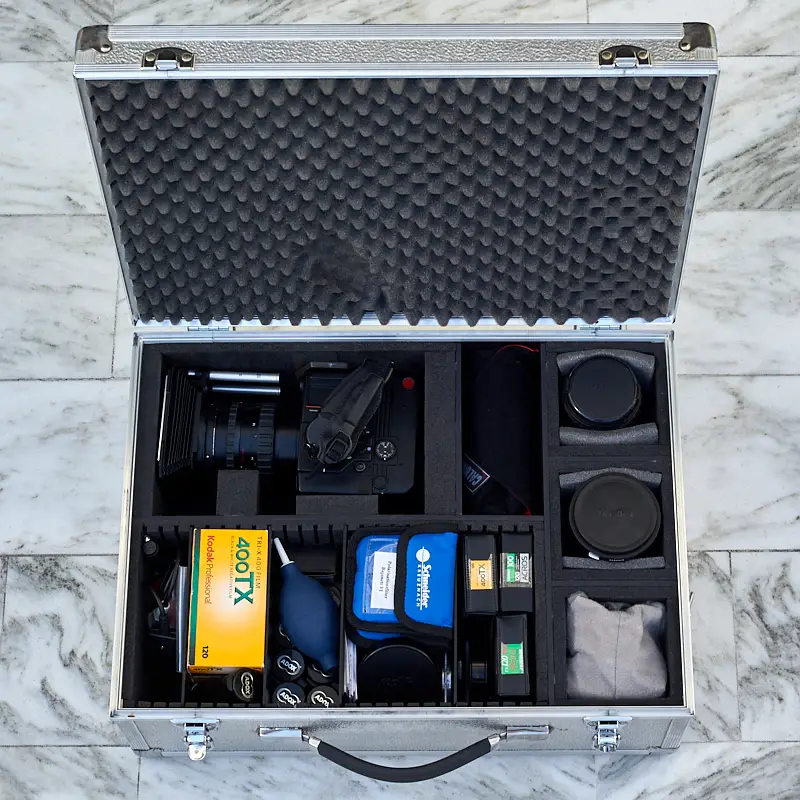
For film developing and printing I used Photostudio 13 in Stuttgart for several years. They provided a reliable and fast service by post. My exhibition prints are scanned, printed and mounted by piCta near Frankfurt. The use Hasselblad Flextight scanners and Durst Lambda printers. I prefer Lambda over Inkjet for black & white prints. For classic baryt prints I turn to Wolfgang Moersch near Cologne who also is an expert for alternative processes and photochemistry.
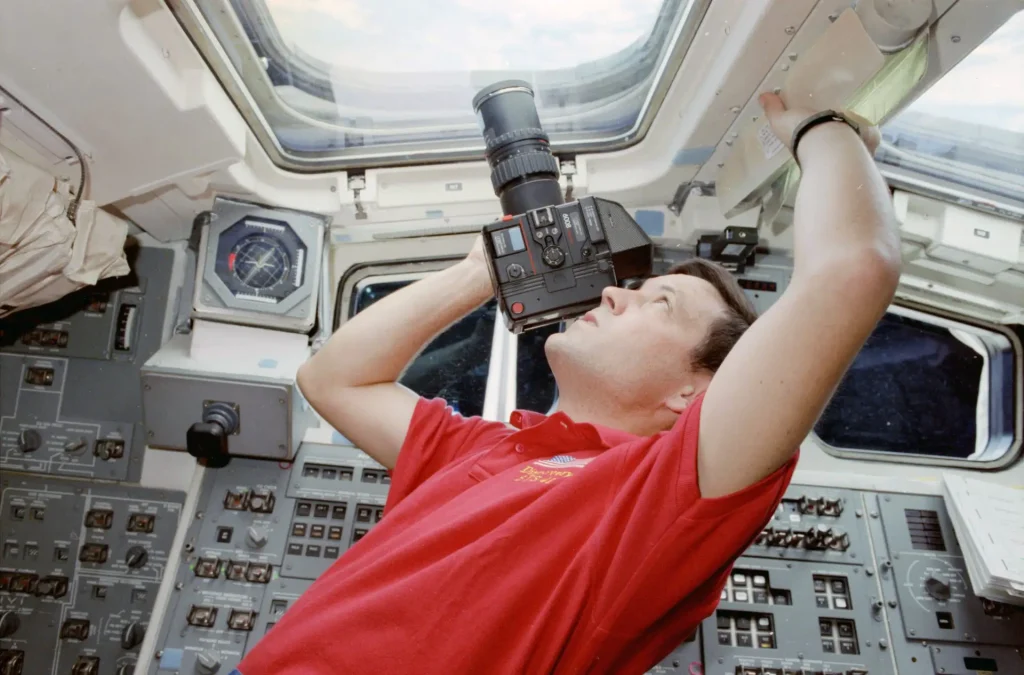
Conclusions
Owning 35mm, medium format and 5×4 inch monorail cameras, the Rolleiflex 6000 system is, for me, something of an ideal compromise between the portability of a 35mm system and the image quality of a large format camera. Due to the modular design of the camera, it can be adjusted to most photographic needs. Every feature (except auto-bracketing) of the Rolleiflex 6008 Professional has turned out to be useful to me and practical for my photographic workflow.
Besides the technical advantages the Rolleiflex 6008 is something I simply enjoy holding in my hand as I appreciate the built quality and the clean-line and functional design.
Having written a lot on technical issues I would like to emphasise that these are insignificant for a good portrait. As written before, portrait photography is, for me, the respectful debate between two people and no monologue. A technical fault will be excused when the portrait is expressive and not the other way round. There are far too many technically excellent, but meaningless photos around.
Resources
Club Rollei User
DHW Fototechnik
Pascal’s Rolleiflex pages
Rolleiflex 6000 System user’s site
Rolleiflex Anleitungen & Broschüren
Rolleiflex Brochures
Rolleiflex User Manuals
Rolleigraphy
Share this post:








Comments
Roland Wengenmayr on Rolleiflex 6000 – A passionate review about a great camera system – by Volker Muth
Comment posted: 11/05/2021
Bob Janes on Rolleiflex 6000 – A passionate review about a great camera system – by Volker Muth
Comment posted: 11/05/2021
Comment posted: 11/05/2021
Comment posted: 11/05/2021
Comment posted: 11/05/2021
Michael J on Rolleiflex 6000 – A passionate review about a great camera system – by Volker Muth
Comment posted: 11/05/2021
I have a long way yet to go to achieve Jedi-mastery of my 'normal' Rolleiflex…
Bud Sisti on Rolleiflex 6000 – A passionate review about a great camera system – by Volker Muth
Comment posted: 11/05/2021
Your knowledge of the Rollei system is impressive, as is your love for the system. Honestly, who wouldn't lust after one? Your article left me needing a cold shower....
However, to play devil's advocate for a moment, your portrait approach (waist level finder, eye contact and interaction, etc.) could mostly be accomplished with any inexpensive TLR from the 50's or 60's. The elegance and sophistication of the Rollei certainly enhance the process, but before any of us start having a GAS attack (probably a fatal one, given the cost of this system), we need to remember that the interpersonal skills and the vision behind the camera are what matter most. That being said, I read your review of the system and had one reaction: GIMME ONE!!
I love photography. I also love its tools. This is one of the most beautifully engineered, capable tools ever created for photographers. You are fortunate to have one to make your vision a reality!
Comment posted: 11/05/2021
Arthur Gottschalk on Rolleiflex 6000 – A passionate review about a great camera system – by Volker Muth
Comment posted: 11/05/2021
Alex Vye on Rolleiflex 6000 – A passionate review about a great camera system – by Volker Muth
Comment posted: 11/05/2021
Marc on Rolleiflex 6000 – A passionate review about a great camera system – by Volker Muth
Comment posted: 11/05/2021
MrSnappy on Rolleiflex 6000 – A passionate review about a great camera system – by Volker Muth
Comment posted: 12/05/2021
images
Eric Jones on Rolleiflex 6000 – A passionate review about a great camera system – by Volker Muth
Comment posted: 12/05/2021
davesurrey on Rolleiflex 6000 – A passionate review about a great camera system – by Volker Muth
Comment posted: 12/05/2021
The discussion of your methodology of portraiture was concise and eloquent and the accompanying photographs show you are more than capable of putting all of that into practise. It makes so much sense.
You would do very well in marketing as after reading about the Rollei 6008 I felt like I wanted to rush out and buy one. It really does seem an incredibly well thought out system.
However my Bronica ETRSi system and I have a special bond over the years and, not being a professional, I can’t justify leaving her for a prettier and much more expensive alternative. We are keepers.
davesurrey on Rolleiflex 6000 – A passionate review about a great camera system – by Volker Muth
Comment posted: 12/05/2021
My understanding has always been that Aperture priority allows one to select an aperture and the metering auto selects the appropriate shutter speed. So shouldn't it be " Move the aperture dial to “A“ and you get shutter priority"? Or is the Rollei terminology different?
My digital LX100 also has dedicated aperture and shutter dials and has an A setting which works just like the Rollei. I find it very intuitive.
Dave
Comment posted: 12/05/2021
Michael on Rolleiflex 6000 – A passionate review about a great camera system – by Volker Muth
Comment posted: 12/05/2021
Great review! I had one, fantastic build quality and the 80mm lens was so sharp, but I sold it because I too had the overlapping exposure problem, and exchange film magazines were hard to find.I wish I'd hung on it...
Sroyon on Rolleiflex 6000 – A passionate review about a great camera system – by Volker Muth
Comment posted: 13/05/2021
A minor detail, I believe the fastest-ever MF lens is actually the Mamiya 80/1.9 (though of course it's for the 645 system, so the DoF is not quite as shallow as the Planar 100/2). Anyway, thanks again for your article – I'm not in the market for a Rollei 6000 series camera, but I still read it with interest and really enjoyed it!
Comment posted: 13/05/2021
Comment posted: 13/05/2021
Paul Jansen on Rolleiflex 6000 – A passionate review about a great camera system – by Volker Muth
Comment posted: 13/05/2021
I also own and use a 6008i with great joy. I have the camera body, plus action grip, and the 45° prism. My glass: the Zeiss 40 f/4.0 FLE, Distagon 50mm f/4.0, Planar 80mm f/2.8, Makro-Planar 120mm f/4.0, and the Schneider Tele-Xenar 180mm f/2.8
When I bought my 6008i new, now 20 years ago, I got my 180mm also new. But I did find a mint used 120mm. Both are dream lenses for portrait. I often use them with a extension tube ET 9mm for a bit closer focussing. For portraits my grail lens would indeed be the Zeiss 110mm f/2.0 Planar. But I guess for the €5000 or so used ebay price one might as well get a used set of the 120mm and the 180mm and still have plenty money left.
My 50mm and 80mm are the EL version which meant that the glass came from Zeiss but were assembled by Rollei. These lenses were cheaper than the proprietary Zeiss version and lacked the 1/1000s shutter times, and the bayonet filter mount. They reach ‘only’ to 1/500s but I am not troubled by that. However they use the threaded filter mount, which can save cost on filters.
Another thing that can save money is not buying the 4560 rotating magazine, they are rare and expensive. But instead use the standard 6x6 magazine. You will indeed loose 4 frames compared to using 4.5 x 6 format. But think of the versatility of having the entire 6x6 image at your disposal. Cropping afterwards, especially digital, is a no brainer. But even when shooting slides, meant for projection, cropping can be done within the slide mounts. Think of how many films you can buy for the about €600 price of a 4560 magazine plus adapter. Plus the 4560 would take up additional space in your bag/case.
A real added treat of the 6x6 format is projecting slides on a screen at least 1.5 x 1.5 m. For this, I bought the Rollei 66 dual P projector included with the AV-Xenotar 2.8/150 mm HFT. Oh goodness! Once a year I run a 6×6 slide show for my digital shooting photo friends. When they watch 6×6 slides projected, even for the umpteenth time, they always fall of their seats as they get hit in the face by the tone, depth, insane sharpness, and overall awesomeness of medium format in this digital age.
Sadly in pop culture and media the Rolleiflex 6008i camera was and is always overshadowed by Hasselblad. But for all the great properties of the Rollei mentioned in your article, this made no sense. Especially when the Zeiss glass for both camera systems was the same and the Schneider glass, on the Rollei was arguably even better.
The period 6008i sales brochures I have proudly showed the German Color Foto Magazine peoples choice award voted best/most loved camera: 1989 through 1996! Don’t know if there were newer brochures with newer votes, at that time I already bought mine!
Micah on Rolleiflex 6000 – A passionate review about a great camera system – by Volker Muth
Comment posted: 13/05/2021
I'd like to add a note of caution, though. I purchased the 180mm f/2.8 a couple of months ago. When I received it, after taking about a dozen test shots, the leaf shutter stopped working. Thankfully, I had gotten it from a reputable seller that included a 90-day warranty. I just found out today that they were unable to source replacement parts, so I'm receiving a full refund. Had I purchased it off, e.g., eBay, I'd be out a *lot* of money.
This is a fantastic medium format system, but do not forget that its sophisticated electronics - which extend to the lenses themselves - are 30 years old, and if they go, there's no guarantee that replacement parts will be available. At the very least, I would recommend that anyone considering buying an expensive body or lens get it from somewhere that includes a warranty, and the longer the better. If it's a 30-day warranty, make sure you'll be able to use the equipment heavily in that time in order to determine if anything's wrong with it.
J on Rolleiflex 6000 – A passionate review about a great camera system – by Volker Muth
Comment posted: 13/05/2021
beware of Ebay ads that provide Lithium rebuilt batteries. According to Rollei specialists, they will fry the cameras electronics and provide you with a door stop that looks like a very expensive camera. Use only NiCad or NiMH batteries.
Now that I have that out of the way, i really enjoyed your review. I had a Hasselblad C/M and I never really cared for the ergonomics. The Rollei 6000 on the other hand has everything right at your finger tips and is much more comfortable to use. Thank you for the excellent review.
Comment posted: 13/05/2021
Rolleiflex 6000 – A Passionate Review – By Volker Moth | Film and Digital Photography from Essential to Esoteric on Rolleiflex 6000 – A passionate review about a great camera system – by Volker Muth
Comment posted: 29/05/2021
Ken Burg on Rolleiflex 6000 – A passionate review about a great camera system – by Volker Muth
Comment posted: 18/07/2021
Comment posted: 18/07/2021
CounterHamish on Rolleiflex 6000 – A passionate review about a great camera system – by Volker Muth
Comment posted: 30/08/2021
Comment posted: 30/08/2021
Piero on Rolleiflex 6000 – A passionate review about a great camera system – by Volker Muth
Comment posted: 27/03/2022
thanks for the wonderful review.
How would you compare the Zeiss 80mm vs the Xenotar for rendering and bokeh? I am trying to decide on which one to buy...
Comment posted: 27/03/2022
Jerry Scoby on Rolleiflex 6000 – A passionate review about a great camera system – by Volker Muth
Comment posted: 29/11/2022
Comment posted: 29/11/2022
David on Rolleiflex 6000 – A passionate review about a great camera system – by Volker Muth
Comment posted: 08/12/2022
Harald on Rolleiflex 6000 – A passionate review about a great camera system – by Volker Muth
Comment posted: 28/12/2022
nice review!
I have been using the modified Lithium Polymer Version by Wiese Fototechnik since 2017/18 , working without any issues on my 6008integral. I have two and they last forever. But you never know ... I am using the Rolleifototechnik lenses, 80 mm Planar (plus 2x teleconverter, 50 mm Distagon. Outstanding camera, good lenses. - A perfect switching-match in combination with my 35 mm contax-equipment.
Harald
PIERRE on Rolleiflex 6000 – A passionate review about a great camera system – by Volker Muth
Comment posted: 30/12/2022